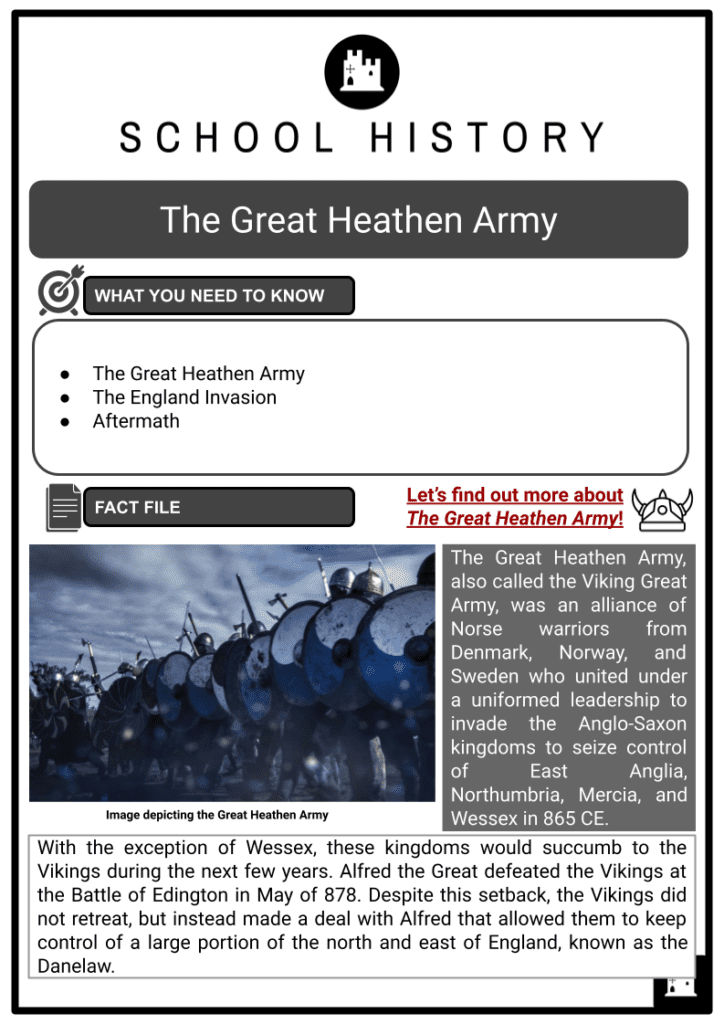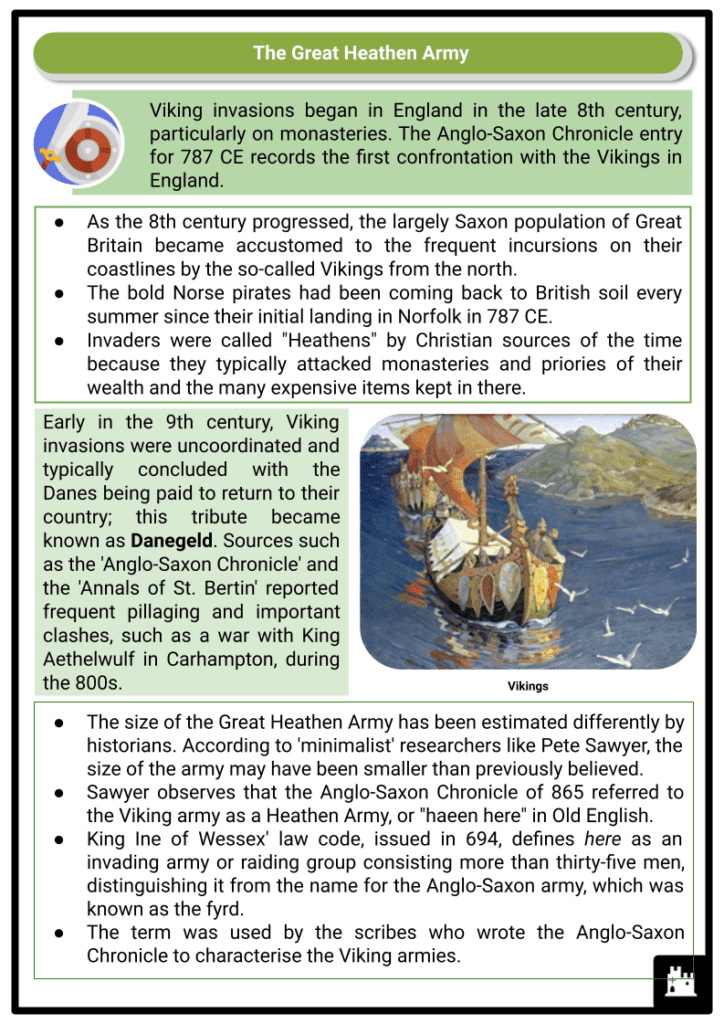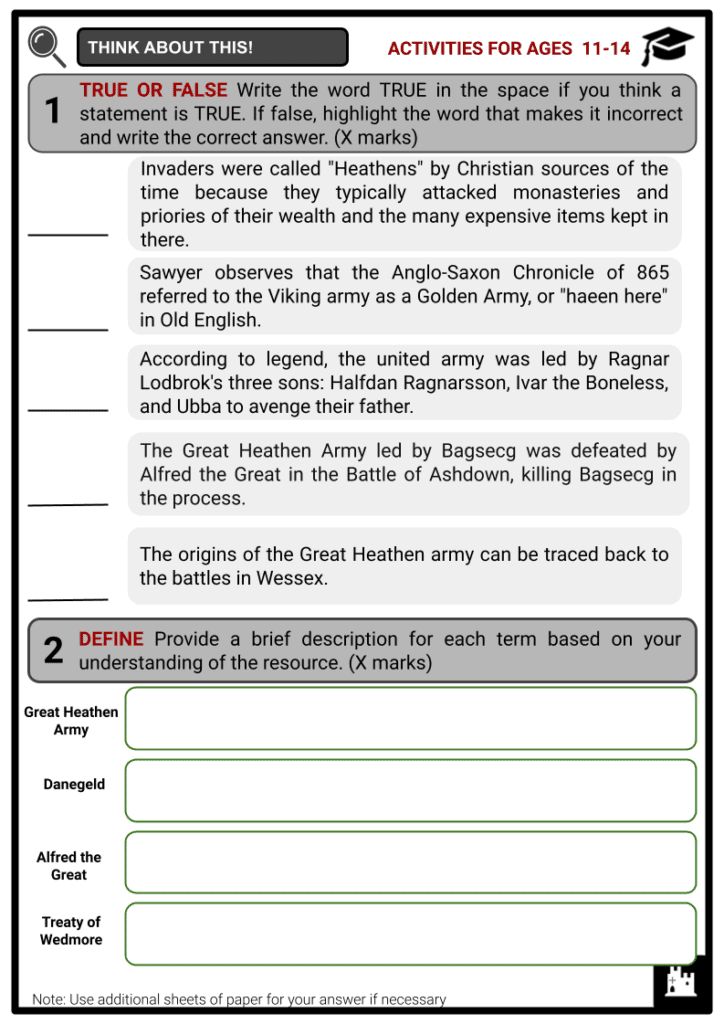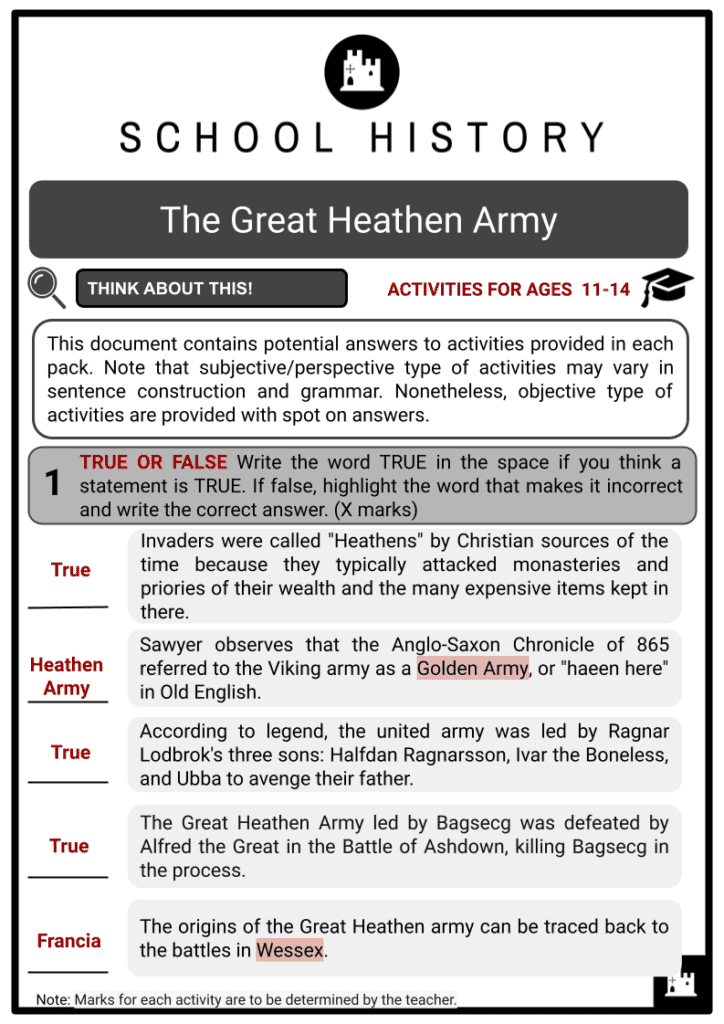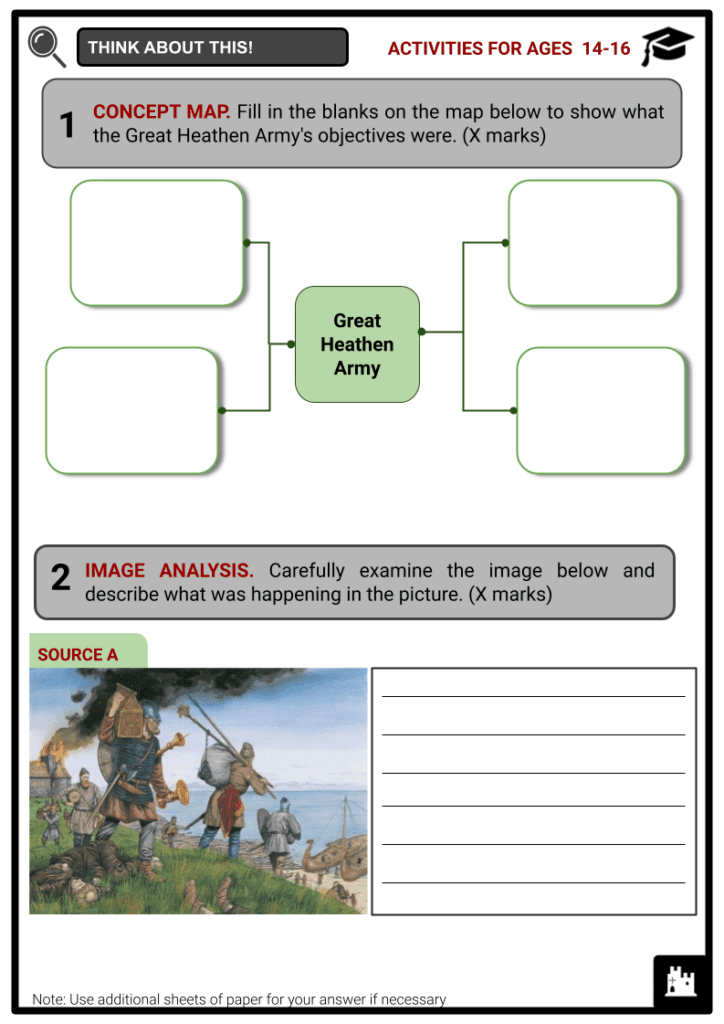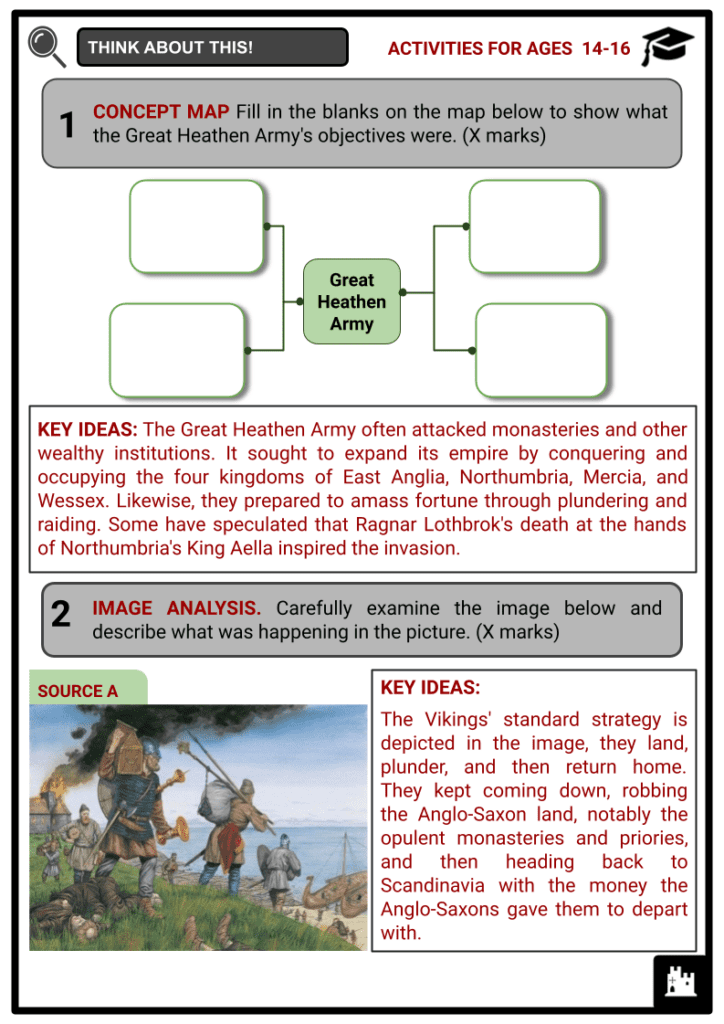The Great Heathen Army Worksheets
Do you want to save dozens of hours in time? Get your evenings and weekends back? Be able to teach about The Great Heathen Army to your students?
Our worksheet bundle includes a fact file and printable worksheets and student activities. Perfect for both the classroom and homeschooling!
Summary
- The Great Heathen Army
- The England Invasion
- Aftermath
Key Facts And Information
Let’s find out more about the Great Heathen Army!
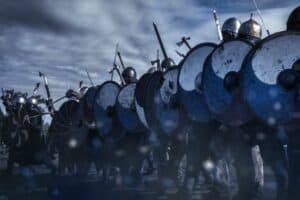
The Great Heathen Army, also called the Viking Great Army, was an alliance of Norse warriors from Denmark, Norway, and Sweden who united under a uniformed leadership to invade the Anglo-Saxon kingdoms to seize control of East Anglia, Northumbria, Mercia, and Wessex in 865 CE.
With the exception of Wessex, these kingdoms would succumb to the Vikings during the next few years. Alfred the Great defeated the Vikings at the Battle of Edington in May of 878. Despite this setback, the Vikings did not retreat, but instead made a deal with Alfred that allowed them to keep control of a large portion of the north and east of England, known as the Danelaw.
The Great Heathen Army
- Viking invasions began in England in the late 8th century, particularly on monasteries. The Anglo-Saxon Chronicle entry for 787 CE records the first confrontation with the Vikings in England.
- As the 8th century progressed, the largely Saxon population of Great Britain became accustomed to the frequent incursions on their coastlines by the so-called Vikings from the north.
- The bold Norse pirates had been coming back to British soil every summer since their initial landing in Norfolk in 787 CE.
- Invaders were called "Heathens" by Christian sources of the time because they typically attacked monasteries and priories of their wealth and the many expensive items kept in there.
- Early in the 9th century, Viking invasions were uncoordinated and typically concluded with the Danes being paid to return to their country; this tribute became known as Danegeld. Sources such as the 'Anglo-Saxon Chronicle' and the 'Annals of St. Bertin' reported frequent pillaging and important clashes, such as a war with King Aethelwulf in Carhampton, during the 800s.
- The size of the Great Heathen Army has been estimated differently by historians. According to 'minimalist' researchers like Pete Sawyer, the size of the army may have been smaller than previously believed.
- Sawyer observes that the Anglo-Saxon Chronicle of 865 referred to the Viking army as a Heathen Army, or "haeen here" in Old English.
- King Ine of Wessex' law code, issued in 694, defines here as an invading army or raiding group consisting more than thirty-five men, distinguishing it from the name for the Anglo-Saxon army, which was known as the fyrd.
- The term was used by the scribes who wrote the Anglo-Saxon Chronicle to characterise the Viking armies.
- Sawyer created a table of Viking ship numbers from the Anglo-Saxon Chronicle, assuming that each Viking ship could carry no more than 32 men, leading him to the conclusion that the army would have been no larger than 1,000 soldiers. Other researchers have come up with higher figures.
- The origins of the army can be traced back to the battles in Francia, where the Emperor had a power struggle with his sons and one of them had accepted assistance from a Viking fleet. By the end of the conflict, the Vikings had learned that monasteries and cities near waterways were easy targets. A substantial sum of silver was paid to the Vikings in 845, preventing them from launching an attack on Paris.
- In 862, in response to Viking attacks, the West Frankish King, Charles the Bald, fortified his towns and defended his rivers. This made inland raids by the Vikings much more difficult. As a result, the coast and the lower portions of the rivers were left vulnerable. In order to avoid the Viking fleets, religious groups in these regions relocated inland. As Francia became more difficult to attack, the Vikings shifted their focus to England.
- Viking chieftains frequently formed alliances for mutual gain, only to disband when their goals had been met. In order to conquer Anglo-Saxon England, several Viking chieftains who had previously operated in Francia and Frisia banded together.
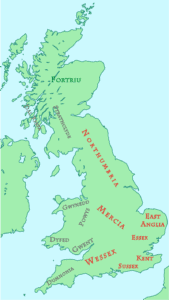
Anglo-Saxon and British kingdoms c. 800 - The combined army likely included warriors from Denmark, Norway, Sweden, and Ireland, in addition to those who had been engaged in combat on the continent. In his chronicle, the Anglo-Saxon historian Aethelweard was quite clear in stating that "the fleets of the Viking tyrant Ivar the Boneless arrived in northern England."
The England Invasion
- The Vikings were defeated by Aethelwulf, King of the West Saxons, in 851, so instead of landing in Wessex, they decided to move farther north to East Anglia.
- According to legend, the united army was led by Ragnar Lodbrok's three sons: Halfdan Ragnarsson, Ivar the Boneless, and Ubba.
- Norse sagas attribute the invasion by the three brothers to their father's death at the hands of King Aella of Northumbria in 865 CE.
- However, the validity of the literary and historical evidence linking Ragnar to the circumstances that led to the invasion of England is the subject of scholarly discussion.
- The exact cause for the invasion is unclear, albeit most likely for financial benefit.
Arrival in East Anglia
- Late in 865, the Great Heathen Army camped on the Isle of Thanet and was given danegeld in exchange for peace by the inhabitants of Kent. Nonetheless, the Vikings disregarded this pact and continued their invasion of eastern Kent.
- The Vikings embarked on an invasion of England starting from East Anglia. As a gesture of goodwill, the East Anglians gave the invaders some horses. After spending the winter in East Anglia, the Vikings pushed on to Northumbria, eventually settling in York at the year's end of 866 CE.
Northumbria
- In 867, the Northumbrians paid danegeld the vikings, and the Viking Army appointed a puppet leader in Northumbria before departing for the Kingdom of Mercia and capturing Nottingham in 867. The king of Mercia asked the king of Wessex for assistance in fighting the Vikings.
- A joint force from Wessex and Mercia besieged the city of Nottingham without achieving a decisive victory, thus the Mercians resorted to paying off the Vikings. The Vikings returned to Northumbria in the fall of 868 and spent the winter and the majority of 869 in York.
- They returned to East Anglia in 869–870 and spent the winter at Thetford. They were attacked in Thetford by Edmund, King of East Anglia, with whom they had no peace treaty. The Vikings won these conflicts, and Edmund was caught and tortured to death. Eventually, he became renowned as Edmund the Martyr.
Attack in Wessex
- In 871, the Great Heathen Army, headed by Bagsecg, landed from Scandinavia. The Vikings moved their attention to Wessex, but the West Saxons, led by King Aethelred's brother, Alfred, destroyed them at the Battle of Ashdown on 8 January 871, killing Bagsecg in the process.
- Three months later, Aethelred died and was succeeded by Alfred, later known as Alfred the Great, who bought off the Vikings to buy time. The army spent the winter of 871–872 in London before returning to Northumbria. It appears that there was a rebellion in Northumbria against the puppet monarch, therefore they returned to restore authority.
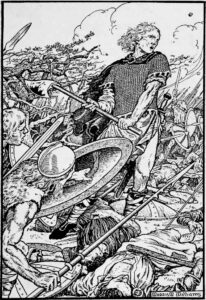
Alfred, the younger brother of Aethelred, depicted at the Battle of Ashdown - They then built their winter quarters in the Kingdom of Lindsey at Torksey for the period of 872- 873, now part of Lincolnshire. The Mercians paid them off again in exchange for peace, and the Vikings took up winter quarters at Repton in Derbyshire around the end of 873.
- After spending the winter at Repton in 874, the Great Heathen Army drove the Mercian king into exile and invaded Mercia. The Mercian king who was exiled was replaced by Ceolwulf. According to the biographer of Alfred the Great, Asser, the Vikings then separated into two groups.
- Halfdan took one band to Northumbria, where he spent the winter beside the Tyne River (874–875). In 875, he went on a raid farther north into Scotland, where he fought Picts and Britons from Strathclyde.
- In 876, upon his return south of the border, he distributed Northumbrian territory to his warriors, who "ploughed the ground and maintained themselves." This territory was a component of the region known as the Danelaw.
King Alfred's triumph
- According to Asser, Guthrum, Oscetel, and Anwend led the second band. This group likewise departed Repton in 874 and established a winter base in Cambridge during 874–875. Late in 875, they went to Wareham, where they conducted raids and occupied a fortified fortress. According to Asser, Alfred negotiated a pact with the Vikings to convince them to leave Wessex.
- The Vikings left Wareham, but it wasn't long before they were raiding other regions of Wessex, with early success. However, Alfred fought back and ultimately defeated them at the Battle of Edington in 878. This was immediately followed by what Asser termed the Treaty of Wedmore, in which Guthrum consented to be baptised and subsequently to leave Wessex with his army.
- Then, some time later, the Treaty of Alfred and Guthrum was signed, which established the territorial limits between Alfred and Guthrum, as well as agreements on peaceful trade and the weregild (man price) value of their respective people.
Aftermath
- Late in 878, Guthrum and his followers fled to the Mercian city of Cirencester. The kingdom then relocated to East Anglia, most likely in late 879, where Guthrum, also called Aethelstan after his baptism, ruled until his death in 890.
- The portion of the army that did not join Guthrum settled primarily in Northumbria and York. Some may have made Mercia their home. This is supported by the fact that the Great Army is thought to be connected to two Viking cemeteries in Derbyshire, at Repton and Heath Wood.
- In the year 878, a third Viking army assembled in Fulham by the Thames. It appears they were partially demoralised by Guthrum's defeat, and Alfred's victory over the Vikings occurred at a time of renewed weakness in Francia.
- The deaths of the Frankish emperor Charles the Bald in 877 and his son shortly thereafter ushered in a time of political turmoil that the Vikings were ready to exploit.
- In 879, the Viking army gathered on the Thames embarked for new campaigns on the mainland.
- In 892, the army that had tented in Fulham returned and re-established itself in Appledore, Kent, consisting of 250 ships.
- Soon after, an additional army of 80 ships stationed in Milton Regis, posing a threat to the West Saxons.
- Subsequently, the army began a series of attacks against Wessex. The Heathen Army made less of an impact against the kingdom than predicted and saw little headway as a result of the King's efforts to repel the invaders and defend Wessex, eventually disbanding in 896.
- By 896, the Viking force had been all beaten and had no reason to continue their raids, so they scattered to East Anglia and Northumbria. Those who were penniless sought ships and sailed south across the sea to the Seine.
- The steady growth of Danelaw was bolstered by this flood of new settlers. Though the Great Heathen Army had devastated Anglo-Saxon England and the Vikings ruled much of the country's northern and eastern regions, Alfred and his successors had successfully maintained their kingdom and held on to power in Wessex.

